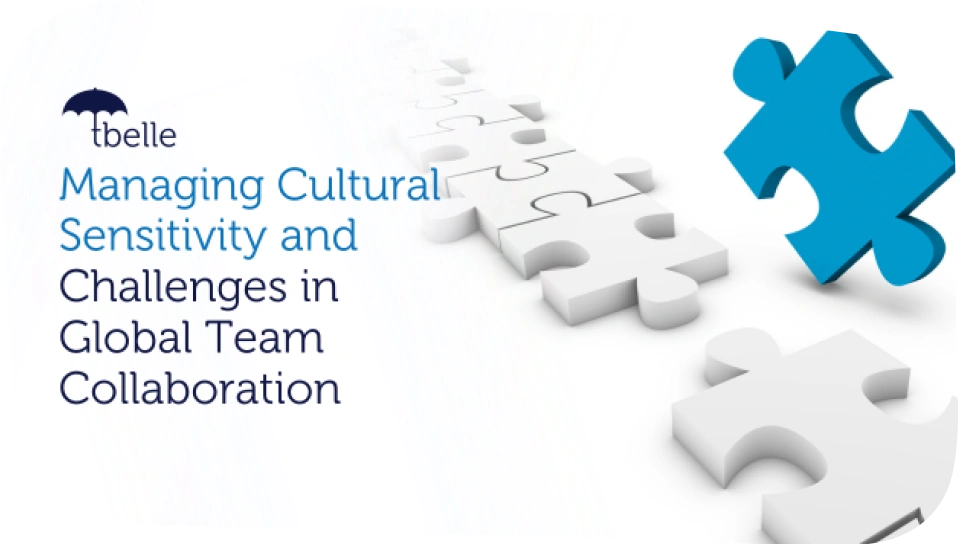Teams that embrace cultural diversity are more creative.

The success of global collaboration hinges not just on technology and processes, but on understanding cultural sensitivity and embracing diversity and inclusivity. A study from the Journal of Organizational Behavior confirms that deep‐level diversity in culturally diverse teams is positively related to team creativity/innovation (J. Wang, et al., 2019).
Managing cultural sensitivity in organizations is essential for navigating the complexities of global team collaboration. This involves recognizing and valuing the unique perspectives and backgrounds each team member brings to the table.
Let’s explore effective strategies for managing cultural sensitivity and overcoming challenges in global team collaboration, ensuring that your teams not only work together but thrive together.
Promoting Cultural Understanding and Sensitivity
- Cultural awareness and sensitivity training
These programs significantly help in fostering an inclusive and harmonious work environment, by educating employees about different cultural norms, values, and practices, helping to reduce misunderstandings and conflicts.
Organizations that invest in cultural intelligence training can possibly see an improvement in cross-cultural interactions. This training helps team members appreciate the diversity within their teams, leading to more respectful and effective communication.
- Language training and its importance
Language barriers can often hinder effective collaboration in global teams. Providing language training to employees can significantly enhance communication and collaboration.
According to a business communication report, 72% of business leaders believe that effective communication has increased their team’s productivity. Language training not only facilitates smoother communication but also shows a commitment to valuing the linguistic diversity of team members, further promoting inclusivity and mutual respect.
- Celebrating diversity and cultural holidays.
Recognizing and celebrating cultural holidays and events is a powerful way to promote inclusivity and cultural sensitivity within an organization. This practice not only acknowledges the diverse backgrounds of employees but also fosters a sense of belonging.
A Deloitte survey revealed that 83% of millennials are actively engaged when they believe their company fosters an inclusive culture. By celebrating various cultural events, companies can create a more inclusive and engaged workforce.
- Creating policies that respect cultural differences.
This includes flexible work arrangements to accommodate different cultural practices, dietary accommodations, and religious observance policies.
Research shows that companies with inclusive policies are 1.7 times more likely to be innovation leaders in their market. Respecting and accommodating cultural differences helps create a workplace where all employees feel valued and supported.
Key Challenges in Global Collaboration

While global collaboration is essential for maintaining a competitive edge, it comes with several challenges that can hinder effective teamwork, if not properly addressed. Understanding and mitigating these challenges is crucial for the success of global teams.
Common Challenges
Coordinating meetings and deadlines across multiple time zones is one of the most significant challenges in global collaboration. For instance, when team members are spread across continents like Asia, Europe, and North America, finding suitable meeting times can be difficult.
A number of remote workers identified time zone differences as a major challenge in their work. This issue can lead to delays in project timelines and decreased productivity.
Miscommunications due to language differences can create misunderstandings and reduce the efficiency of a global team. According to a study, 64% of executives believe language barriers can cause inefficiencies and a lack of collaboration among international teams. Clear and effective communication is vital for coordinating tasks and ensuring everyone is on the same page.
Ensuring that all team members have access to reliable technology can be challenging, especially when working with remote and offshore teams.
Disparities in internet connectivity, hardware, and software can hinder effective communication and collaboration. A survey by Gartner revealed that 60% of employees encounter technical difficulties that affect their productivity when working remotely.
Differing work styles and expectations due to cultural differences can lead to misunderstandings and conflict within global teams. A study by Hofstede Insights highlights that cultural differences can impact various aspects of teamwork, such as decision-making processes, communication styles, and attitudes towards hierarchy and authority. These misunderstandings can create friction and reduce team cohesion.
Solutions and Strategies
Allowing employees to work flexible hours can help accommodate different time zones and ensure that team members can collaborate effectively without overextending their working hours.
A Stanford study found that flexible work arrangements can increase productivity by 13%. This approach helps maintain a work-life balance while ensuring that all team members can participate in meetings and collaborate on projects.
Regular cultural exchange sessions can help team members learn about each other’s cultures, work styles, and expectations. These sessions can reduce cultural misunderstandings and foster a more inclusive and cohesive team environment.
Providing uniform and reliable technology for all team members is essential for effective global collaboration. Companies should invest in robust communication tools, project management software, and reliable internet connectivity to ensure smooth operations.
More than 40% of workers surveyed in a McKinsey report indicate that they spend at least 25% of their work week on manual, repetitive tasks. Investing in automation and technology can help businesses increase their employees’ productivity by integrating automation and reliable technological tools.
Establishing clear processes for addressing and resolving conflicts is crucial for maintaining harmony within a global team. Conflict resolution protocols should include guidelines for identifying issues, open communication channels, and mediation strategies.
According to a study by CPP Global, 85% of employees at all levels deal with conflict at work. Having structured protocols ensures that conflicts are addressed promptly and fairly, fostering a positive and collaborative work environment.
Building Trust and Fostering Strong Relationships

Establishing trust and strong relationships within a global team is foundational to successful collaboration. Trust enables team members to rely on each other, share ideas openly, and work together efficiently, which is crucial for overcoming the challenges of global collaboration.
Here are some strategies and approaches to building trust and fostering strong relationships in global teams.
Trust-Building Strategies
Engaging in virtual team-building activities can significantly enhance trust and camaraderie among team members. Activities such as online games, virtual escape rooms, and team challenges can help break the ice and build rapport.
According to research, the number of companies investing in virtual team building has risen by 2,500%. These activities help create a sense of community, even when team members are geographically dispersed.
A survey by Edelman Trust Barometer found that 67% of employees consider transparent communication from their leadership as one of the most important factors in building trust. Regular updates, open forums for questions, and clear channels for feedback can enhance transparency and trust within the team.
Transparent communication is essential for building trust. When team members are open about their progress, challenges, and expectations, it fosters a culture of honesty and reliability.
Regular recognition and appreciation of team members’ contributions can significantly boost morale and trust. A study by Gallup shows that employees who receive regular recognition are five times as likely to be connected to company culture and four times as likely to be engaged.
Acknowledging achievements, both big and small, and expressing gratitude can make team members feel valued and motivated to contribute their best work.
Relationship Building
According to research by MIT Sloan Management Review, informal interactions can enhance team cohesion and improve overall performance. Encouraging informal interactions can help team members build personal connections beyond work tasks.
Virtual coffee breaks, casual chat channels, and social events can provide opportunities for team members to get to know each other on a personal level.
Implementing mentorship programs can provide support and guidance for new team members and facilitate knowledge sharing across the team. Mentorship helps build strong, trusting relationships and promotes professional development.
Whenever possible, organizing in-person meetings or retreats can deepen connections and build trust among team members. Face-to-face interactions allow for more personal communication and can solidify relationships formed virtually.
Incorporating Geert Hofstede’s Cultural Dimension Model
Geert Hofstede’s cultural dimension model is a valuable framework for understanding and managing cultural differences within global teams. The model identifies six dimensions of national culture that affect behavior in the workplace:
- Power Distance, Individualism vs. Collectivism
- Masculinity vs. Femininity
- Uncertainty Avoidance
- Long-Term Orientation vs. Short-Term Orientation
- Indulgence vs. Restraint
By applying Hofstede’s model, teams can better understand the cultural backgrounds of their members and tailor their communication and collaboration strategies accordingly. For example, in cultures with high Power Distance, team members may expect clear hierarchies and direct instructions from leaders, while those from low Power Distance cultures may prefer more egalitarian and participative approaches. Understanding these nuances can help in building more cohesive and effective teams.
Conclusion
As teams grow more diverse, they become more creative and innovative. By promoting cultural understanding, and addressing key challenges in global team collaboration, businesses can create dynamic global teams that are more innovative, efficient, and capable of overcoming the challenges of the modern business environment. These efforts not only enhance collaboration but also contribute to the overall success and
Key Takeaways:
For a successful team, it helps to promote cultural understanding and sensitivity through:
- Training Programs:
- Inclusive Policies
- Addressing Key Challenges in Global Collaboration:
- Time Zone Differences
- Language Barriers
- Technological Disparities
- Cultural Misunderstandings
- Building Trust and Fostering Strong Relationships
- Trust-Building Strategies
- Relationship Building










